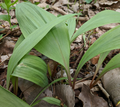Allium tricoccum
-
Allium tricoccum in Vermont, USA
-
Allium tricoccum var. tricoccum
-
Allium burdickii
-
Ramps on forest floor
-
Wild leeks on Whitefish Island
-
Bunch of ramps
Allium tricoccum[edit]
Allium tricoccum, commonly known as ramps, wild leeks, or spring onions, is a perennial plant native to the woodlands of eastern North America. It is a member of the Amaryllidaceae family, which also includes onions, garlic, and chives.
Description[edit]
Allium tricoccum is a herbaceous plant that grows from a small bulb. The plant typically emerges in early spring, with broad, smooth, light green leaves that are 10–15 cm long and 2–5 cm wide. The leaves have a distinctive garlic-like odor. By early summer, the leaves die back, and the plant produces a single flowering stalk, or scape, that can reach up to 50 cm in height. The scape bears a cluster of small, white flowers.
Habitat[edit]
Ramps are found in rich, moist, deciduous forests, often in shaded areas. They prefer well-drained, loamy soils and are commonly found in the understory of maple, beech, and oak forests. The plant is native to regions ranging from Quebec and Ontario in Canada, south to Georgia and Alabama in the United States.
Ecology[edit]
Allium tricoccum plays an important role in forest ecosystems. It is one of the first plants to emerge in the spring, providing an early source of food for wildlife. The plant is also a host for various insects and contributes to the biodiversity of forest floor communities.
Culinary Uses[edit]
Ramps are highly prized for their culinary uses. Both the leaves and bulbs are edible and have a strong, pungent flavor that is a cross between garlic and onion. They are often used in salads, soups, and pesto, or simply sautéed as a side dish. Ramps are a traditional food in many Appalachian communities and are celebrated in festivals throughout the region.
Conservation[edit]
Due to their popularity and slow growth rate, ramps are susceptible to overharvesting. Sustainable harvesting practices are important to ensure the long-term survival of wild populations. This includes harvesting only a portion of the plants in a given area and leaving the bulbs in the ground to regenerate.
Related pages[edit]
Ad. Transform your life with W8MD's Budget GLP-1 injections from $75


W8MD offers a medical weight loss program to lose weight in Philadelphia. Our physician-supervised medical weight loss provides:
- Weight loss injections in NYC (generic and brand names):
- Zepbound / Mounjaro, Wegovy / Ozempic, Saxenda
- Most insurances accepted or discounted self-pay rates. We will obtain insurance prior authorizations if needed.
- Generic GLP1 weight loss injections from $75 for the starting dose.
- Also offer prescription weight loss medications including Phentermine, Qsymia, Diethylpropion, Contrave etc.
NYC weight loss doctor appointmentsNYC weight loss doctor appointments
Start your NYC weight loss journey today at our NYC medical weight loss and Philadelphia medical weight loss clinics.
- Call 718-946-5500 to lose weight in NYC or for medical weight loss in Philadelphia 215-676-2334.
- Tags:NYC medical weight loss, Philadelphia lose weight Zepbound NYC, Budget GLP1 weight loss injections, Wegovy Philadelphia, Wegovy NYC, Philadelphia medical weight loss, Brookly weight loss and Wegovy NYC
|
WikiMD's Wellness Encyclopedia |
| Let Food Be Thy Medicine Medicine Thy Food - Hippocrates |
Medical Disclaimer: WikiMD is not a substitute for professional medical advice. The information on WikiMD is provided as an information resource only, may be incorrect, outdated or misleading, and is not to be used or relied on for any diagnostic or treatment purposes. Please consult your health care provider before making any healthcare decisions or for guidance about a specific medical condition. WikiMD expressly disclaims responsibility, and shall have no liability, for any damages, loss, injury, or liability whatsoever suffered as a result of your reliance on the information contained in this site. By visiting this site you agree to the foregoing terms and conditions, which may from time to time be changed or supplemented by WikiMD. If you do not agree to the foregoing terms and conditions, you should not enter or use this site. See full disclaimer.
Credits:Most images are courtesy of Wikimedia commons, and templates, categories Wikipedia, licensed under CC BY SA or similar.
Translate this page: - East Asian
中文,
日本,
한국어,
South Asian
हिन्दी,
தமிழ்,
తెలుగు,
Urdu,
ಕನ್ನಡ,
Southeast Asian
Indonesian,
Vietnamese,
Thai,
မြန်မာဘာသာ,
বাংলা
European
español,
Deutsch,
français,
Greek,
português do Brasil,
polski,
română,
русский,
Nederlands,
norsk,
svenska,
suomi,
Italian
Middle Eastern & African
عربى,
Turkish,
Persian,
Hebrew,
Afrikaans,
isiZulu,
Kiswahili,
Other
Bulgarian,
Hungarian,
Czech,
Swedish,
മലയാളം,
मराठी,
ਪੰਜਾਬੀ,
ગુજરાતી,
Portuguese,
Ukrainian





